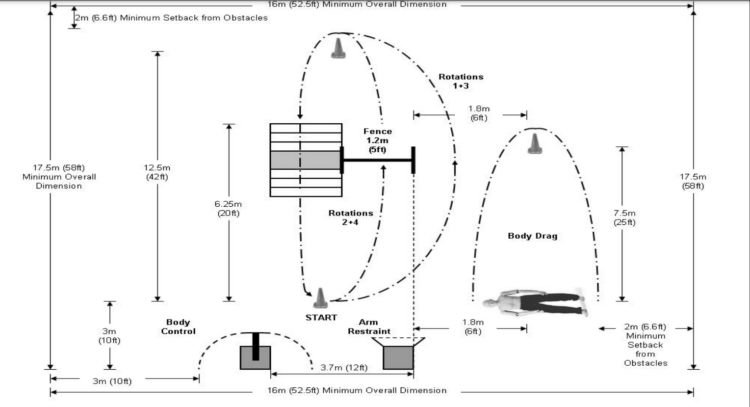The Alberta Physical Abilities Readiness Evaluation for Police Officers (APREP) fitness test is a critical step for anyone aiming to join a police force in Alberta. Edmonton, Calgary, Lethbridge, Medicine Hat, Camrose and Grande Prairie police services all require a valid APREP to move forward in their recruiting process. This test measures a candidate’s strength, endurance, and agility, essential attributes for tackling the physical demands of a law enforcement career. Understanding the stages of the APREP test and how best to prepare for them can give you the advantage needed to pass successfully and proceed confidently in your application.

Stages of the APREP Fitness Test
The APREP test is a high-intensity assessment composed of two primary stages, both designed to gauge the core physical competencies needed for a policing role. Here’s a breakdown of each stage, including what you’ll need to demonstrate at each step:
1. Obstacle Course Simulation
The first portion of the APREP involves a circuit-style course that simulates an emergency response in which a police constable pursues an offender a distance of 100 m while scaling four sets of stairs and two fences, engages in a physical altercation to accomplish the control and restraint of a resisting offender, then drags a passive resister or accident victim to a triage area. Throughout this test, you wear a weighted belt (7.5 kg or 16.5 lb) around your waist to simulate the weight of standard police equipment.
- In the pursuit phase of the test, you run four laps around a 25-metre (83 ft) circuit as quick as possible for a total distance of 100 metres (332ft). During each 25-metre circuit, you climb a set of 5 stairs and, during the second and forth rotations of the circuit, you scale a 1.5 –metre (5ft) fence. The set of 5 stairs measure cardiovascular fitness and lower body strength.
- The fence is solid and has a toe-hold 18 inches above the ground. You must use the toe hold and roll over the fence. This tests upper body and grip strength and ensures that candidates can safely regain balance after an impact or fall.
Station 2: Push/pull section (physical control)
The Push and Pull Station and Handcuff Simulator are tests of upper body and core strength, requiring you to complete a set number of push and pull repetitions against a set resistance. These stations assess both your muscular endurance and strength capacity.
Immediately following the 100-metre (332 ft) circuit, you move to the Body Control Simulator (Push/Pull Machine) and grasp the handle. You then move through two 180º arcs switching back and fourth every 90º between pushing and pulling the handle to raise a weight of 34 kg (75 lb).
You then move to the Arm Restraint Simulator (Handcuff Machine) and grasp the handles, then depress the grips of both arms of the simulator. It takes 14.5 kg (32 lb) of force to depress each grip. With the grips constantly depressed, the arms of the machine are forced together and then returned to their starting position. It takes 16 kg (35 lb) of force to retract each arm.
You then return to the Body Control Simulator (Push./Pull Machine) and repeat the pushing and pulling to raise the 34 kg (75 lb) weight through two more 180º arcs (Figure 6).
You once again return to the Arm Restraint Simulator and repeat the arm retraction exercise.
Station 3. Torso Bag Carry (carry to safety)
This simulates having to remove an object or a person from the scene
Lastly, you grasp a 68 kg (150 lb) body and drag it a distance of 15 metres (50 ft). You may grasp the body by the wrists or by the ankles.
The Pursuit/Restraint Circuit is scored as the total time from the start of the 100-metre (332 ft) circuit to the completion of the body drag. Completing these obstacles within the allotted time and with proper form is essential to pass this part of the test.
Following completion of the Pursuit/Restraint Circuit, you’re allowed a minimum 10-minute rest before beginning the aerobic fitness test.
For successful completion of the Pursuit/Restraint Circuit the time must be 2 minutes and 10 seconds or less.

STAGE 2
The Aerobic Fitness Test portion of the APREP requires the completion of the 20-meter Shuttle Run (Leger or Beep Test), which is designed to evaluate aerobic fitness and work capability during physically demanding policing tasks as well as everyday policing activities.
In this test, you run back and forth between two marked lines over a 20-meter course in time with taped audio signals. The time permitted at the beginning of the test to cover the 20-meter distance requires a slow jog. Thereafter, for each 20-metres, the time between audio signals lessens, requiring that you pick up your running pace. The audio signal informs you of the “stage” you are at as the test progresses.
In each leg of the shuttle run, warning lines, placed 2 meters before each of the 20-meter end lines, must be reached before the permitted time elapses and the audio signal sounds.
An examiner will caution you if you fail to cross a warning line in time. The test ends when you miss two consecutive warning lines.
To successfully complete the minimum requirement of the aerobic fitness test you must achieve Stage 7.0 in the 20-metre Shuttle Run.
An acceptable score on the Aerobic Shuttle Run component requires approximately the same level of fitness as running 2.4 km (1.5 miles) in 11.5 minutes for a level 7.
Preparing for the APREP Fitness Test
The APREP test demands a high level of physical readiness, so it’s essential to start early and adopt a structured, consistent training approach well before you plan on applying to your police force. Focusing on specific areas like cardiovascular fitness, muscular strength, agility, and endurance can make a significant difference. Here’s a targeted plan to help you begin:
1. Cardiovascular Conditioning
Since a large part of the APREP is aerobic, interval training and sustained endurance exercises are highly effective. Try incorporating HIIT workouts, running, or stair climbing into your routine to boost your cardiovascular capacity. Several agencies host Run with A Recruiter sessions that you can join and Blue Line Fitness Testing also runs weekly fitness classes such as our Mighty Titans and Officer Bootcamp to boost that fitness.
2. Strength Training
To tackle the wall climbs and push/pull, focus on building upper body, lower body, and core strength. Weighted exercises like squats, lunges, bench presses, and deadlifts are great choices. Practicing bodyweight exercises like push-ups and pull-ups can also help build endurance for these demanding tasks. To get an opportunity to practice on the push/pull machine at your own pace, Blue Line offers our Open Gym classes every Saturday morning from 10-11am.
3. Agility and Coordination
Drills that emphasize quick changes in direction—such as agility ladder exercises, cone drills, or plyometrics—can enhance coordination and improve reaction times for the obstacle course simulation.
4. Recovery and Mobility
Preparing for the APREP is about more than just physical fitness. Mobility exercises, dynamic stretching, and consistent recovery practices like foam rolling can reduce injury risks, improve flexibility, and support muscle recovery for optimal performance on test day. Adding a yoga class once per week is a great way to recover and work on your mental wellness and preparation for stressful scenarios and situations.
How Blue Line Fitness Testing Can Help
At Blue Line Fitness Testing, we specialize in helping future law enforcement officers prepare for fitness exams like the APREP. Our APREP training program focuses on each of the test stages, with expert-led sessions designed to build the strength, endurance, and agility needed to pass. We also provide personalized training sessions, mock APREP test simulations, and access to essential feedback, helping you understand where you stand and what to focus on to improve.
If you’re looking for a more structured approach, our Officer Bootcamp programs can guide you through every step, offering support from experienced trainers and law enforcement fitness specialists. From one-on-one coaching to group fitness classes focused on law enforcement requirements, Blue Line Fitness Testing is here to ensure that you feel confident and ready to excel.
Start your APREP preparation journey today with a visit to Blue Line Fitness Testing! Contact us to schedule your first session and take the first step towards a rewarding career in law enforcement.






